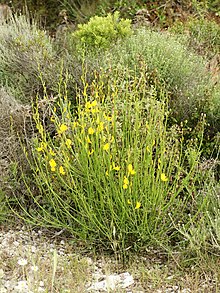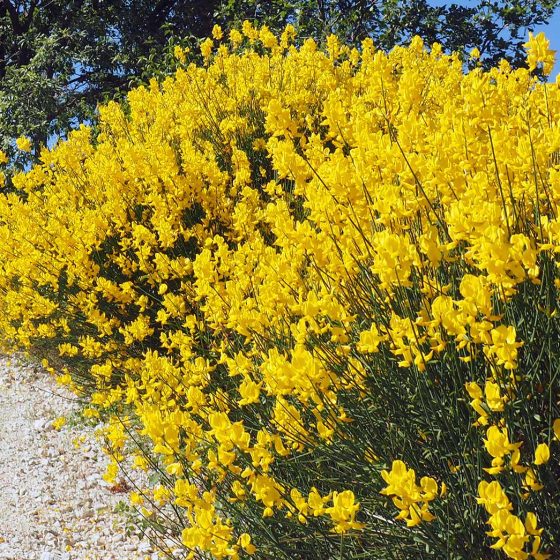Nome comune: ginestra, ginestra odorosa
Specie: Spartium junceum L.
Famiglia: FABACEAE
Si tratta di un arbusto perenne, privo di spine, alto fino a 3 m, con steli, cilindrici e leggermente carnosi, lisci e flessuosi.
- I fiori, decisamente profumati, sono bilabiati, ad ali distese, lunghi fino a 2,5 cm.
- Le foglie sono piccole, di forma lanceolata, lunghe in genere non più di 3 cm, pelosette nella pagina inferiore.
- Il frutto, detto baccello, è appiattito, di colore marrone a maturità, contiene dai 10 ai 18 semi.
- I semi cadono per gravità a poca distanza dalla pianta madre.
Tossicità
Nei fiori e in generale in tutta la pianta delle diverse specie di ginestre (soprattutto nella ginestra dei carbonai, Cytisus scoparius) sono presenti vari composti tossici, tra cui alcaloidi, saponine ecc.
L’avvertenza, pertanto, è di non utilizzare le ginestre per preparare medicamenti erboristici e di non ingerire alcuna parte di questi arbusti: accontentiamoci, e non ci pare poco, di godere della bellezza di queste piante, abbagliante quando sono all’acme della loro splendida ed abbondante fioritura.
Curiosità
Le fioriture delle ginestre, generalmente gialle e profumate, sono indubbiamente un incanto dei nostri monti e delle nostre colline a tarda primavera, una componente pregevole ed essenziale dei nostri panorami naturali.
Negli ultimi tempi sono diventate piuttosto comuni ed utilizzate per abbellire gli spazi verdi anche varietà da giardino e da balcone, selezionate con colorazioni differenti.
 Link da Actaplantarum: Spartium junceum
Link da Actaplantarum: Spartium junceum
| Spartium | |
|---|---|

| |
| Scientific classification | |
| Kingdom: | Plantae |
| Clade: | Tracheophytes |
| Clade: | Angiosperms |
| Clade: | Eudicots |
| Clade: | Rosids |
| Order: | Fabales |
| Family: | Fabaceae |
| Subfamily: | Faboideae |
| Tribe: | Genisteae |
| Genus: | Spartium L. |
| Species: | S. junceum
|
| Binomial name | |
| Spartium junceum L.
| |
| Synonyms | |
|
Genus:
Species:
| |
Spartium junceum, known as Spanish broom,[1] rush broom, or weaver's broom,[2] it is a species of flowering plant in the family Fabaceae and the sole species in the genus Spartium.[3][4][5] It is closely related to the other brooms (in the genera Cytisus and Genista).
Description
Spartium junceum is a vigorous, deciduous shrub growing to 2–4 metres (7–13 feet) tall, rarely 5 m (16 ft), with main stems up to 5 centimetres (2 inches) thick, rarely 10 cm (4 in). It has thick, somewhat succulent grey-green rush-like shoots with very sparse small deciduous leaves 1 to 3 cm (1⁄2 to 1+1⁄4 in) long and up to 4 millimetres (1⁄8 in) broad. The leaves are of little importance to the plant, with much of the photosynthesis occurring in the green shoots (a water-conserving strategy in its dry climate). The leaves fall away early.[6] In late spring and summer shoots are covered in profuse fragrant yellow pea-like flowers 1 to 2 cm across. In late summer, the legumes (seed pods) mature black and reach 8–10 cm (3–4 in) long. They burst open, often with an audible crack, spreading seed from the parent plant.
Taxonomy
The Greek name Spartium given to the genus denotes the use of the plant for 'cordage'.[7] The Latin specific epithet junceum means "rush-like", referring to the shoots, which show a passing resemblance to those of the rush genus Juncus.[8]
Distribution and habitat
This species is native to the Mediterranean in southern Europe, southwest Asia and northwest Africa,[9] where it is found in sunny sites, usually on dry, sandy soils.
As an invasive species
Spartium junceum has been widely introduced into other areas, and is regarded as a noxious invasive species in places with a Mediterranean climate such as California and Oregon, Hawaii, central Chile, southeastern Australia,[10] the Western Cape in South Africa and the Canary Islands and Azores.[9][11] It was first introduced to California as an ornamental plant.[11][12]
Toxicity
Few cases have been described of intoxication by the S. junceum, including accidental ingestion of different parts of the plant by children.[13] The alkaloids found in all parts of the plant have toxic effects. They initially provoke a transitory stimulation of nicotinic cholinergic receptors followed by a persistent inhibition caused by desensitization. The sparteine has an effect of the heart, reducing its sensitivity and conductivity.[14]
Symptoms present depending on dose, method of exposure, and time elapsed since exposure; these include irritation of the oral and pharyngeal mucosa, hypersalivation, vomiting, stomach pain and diarrhea. In severe cases, neurological symptoms (such as midriasis, headaches, delirium and convulsions) may be present, as well as hypotension, bradycardia, and coma.[14]
Uses
The plant is used as an ornamental plant in gardens and in landscape plantings. It has gained the Royal Horticultural Society's Award of Garden Merit.[2][15]
In Bolivia and Peru, where it is known as retama,[9] (not to be confused with the genus Retama) and has become invasive in some areas. It is one of the most common ornamental plants, often seen growing along sidewalks in La Paz.[citation needed]
It has traditionally been used for the production of fiber, especially for tying vines. It is also used as a hedge because of its nitrogen-fixing quality. The plant is also used as a flavoring, and for its essential oil, known as genet absolute.[9][16] Its fibers have been used for cloth and it produces a yellow dye.[16][17] The branches are used to make brooms.[18]
Pharmacology
In work carried out on normoglycemic mice at the Faculty of Chemistry of the University of the Republic of Uruguay, the infusion of the flowers were proven to have hypoglycemiant effects.[19] In Turkey, the flowers have been used in traditional medicine to treat ulcers; Turkish studies from 1999 and 2000 have identified a saponin in the plant which has antiulcer properties.[20][21]
Culture
Spartium junceum has made its way into the ethnobotany of the indigenous Aymara and Quechua cultures, in which it is believed to protect against evil, probably influenced by similar traditions of Hispanic origin.[citation needed] In Peru, it is known as retama, qarwash, inca pancara, talhui.[22]
The Peruvian huayno, Flor de Retama, written by Ricardo Dolorier in 1969, references the yellow flower and the Huanta massacre which occurred that year. Subsequently, all retama flowers were removed from the main plaza out of fear of government repression; today, the entrances to Huanta are planted with the flower.[23]
Known in Catalan as ginesta, it has often been regarded as the national flower of Catalonia, sometimes in combination with red poppies.[24]
Gallery
-
A stand of plants with many blooms, France
-
Flowers
-
Close-up of a flower
-
Mature fruit
References
- ^ NRCS. "Spartium junceum". PLANTS Database. United States Department of Agriculture (USDA). Retrieved 24 November 2015.
- ^ a b "RHS Plant Selector - Spartium junceum". Retrieved 14 February 2020.
- ^ "ILDIS LegumeWeb entry for Spartium". International Legume Database & Information Service. Cardiff School of Computer Science & Informatics. Retrieved 15 April 2014.
- ^ USDA; ARS; National Genetic Resources Program. "GRIN species records of Spartium". Germplasm Resources Information Network—(GRIN) [Online Database]. National Germplasm Resources Laboratory, Beltsville, Maryland. Retrieved 15 April 2014.
- ^ "The Plant List entry for Spartium". The Plant List. Royal Botanic Gardens, Kew and the Missouri Botanical Garden. 2013. Retrieved 15 April 2014.
- ^ Jepson Manual Treatment
- ^ "A Modern Herbal | Broom, Spanish". www.botanical.com. Retrieved 2021-04-03.
- ^ A–Z encyclopedia of garden plants. London, United Kingdom: Dorling Kindersley in association with the Royal Horticultural Society. 2008. p. 1136. ISBN 978-1405332965.
- ^ a b c d "Spartium junceum". Germplasm Resources Information Network. Agricultural Research Service, United States Department of Agriculture. Retrieved 17 December 2017.
- ^ "The NSW Government WeedWise Resource from the Department of Primary Industries".
- ^ a b US Forest Service Fire Ecology
- ^ Element Stewardship: S. junceum
- ^ Martínez Monseny, A.; Martínez Sánchez, L.; Margarit Soler, A.; Trenchs Sainz de la Maza, V.; Luaces Cubells, C. (2015-05-01). "Poisonous plants: An ongoing problem". Anales de Pediatría (English Edition). 82 (5): 347–353. doi:10.1016/j.anpede.2014.08.006. ISSN 2341-2879.
- ^ a b Tesouro Rodríguez, L.; Saiz Rodríguez, I.; Molina Gutiérrez, M.A.; Rivas Paterna, M.A.; López López, R.; Bueno Barriocanal, M. (December 2014). "Intoxicación por Spartium junceum (Spanish broom)". Anales de Pediatría (in Spanish). 81 (6): e32 – e33. doi:10.1016/j.anpedi.2013.12.008. ISSN 1695-4033. PMID 24582126.
- ^ "AGM Plants - Ornamental" (PDF). Royal Horticultural Society. July 2017. p. 99. Retrieved 16 November 2018.
- ^ a b "FAO". Archived from the original on 2016-03-04. Retrieved 2010-08-13.
- ^ botanical.com
- ^ Macía, Manuel J. (2006). Moraes R., Mónica (ed.). "Las plantas de fibra". Botánica económica de los Andes centrales (in Spanish). Universidad Mayor de San Andrés: 378. ISBN 9789995401214. OCLC 192083315.
- ^ Hipoglucemiantes -agentes : aloxano y plantas en general, acción hipoglucemiante de flor de retama (Saprtium junceum), Biblioteca-FQ, 1990, retrieved 2024-01-18
- ^ Yeşilada, E.; Takaishi, Y. (August 1999). "A saponin with anti-ulcerogenic effect from the flowers of Spartium junceum". Phytochemistry. 51 (7): 903–908. Bibcode:1999PChem..51..903Y. doi:10.1016/s0031-9422(99)00198-3. ISSN 0031-9422. PMID 10423862.
- ^ Yeşilada, E.; Takaishi, Y.; Fujita, T.; Sezik, E. (June 2000). "Anti-ulcerogenic effects of Spartium junceum flowers on in vivo test models in rats". Journal of Ethnopharmacology. 70 (3): 219–226. doi:10.1016/s0378-8741(99)00180-4. ISSN 0378-8741. PMID 10837986.
- ^ Alarco de Zadra, Adriana (2000). Perú: El libro de las plantas mágicas (in Spanish) (2nd ed.). p. 195. OCLC 45860046.
- ^ Reynoso, Christian (2009-11-15). "Dolorier y la flor de Retama: pólvora y dinamita del corazón". Los Andes. Retrieved 2024-01-18.
- ^ (in Catalan) La ginesta, flor nacional de Catalunya





